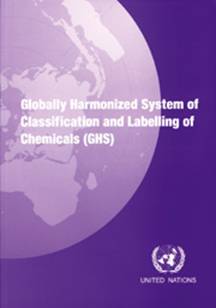
The Globally Harmonized System (GHS) of Classification and Labeling of Chemicals is a system for standardizing and harmonizing the classification and labeling of chemicals. The GHS provides 3 basic elements for classification and labeling:
- Define health, physical & environmental hazards
- Classify the hazards
- Communicate the hazards throughout the workforce via labels and Safety Data Sheets (SDS) – note: comparison of SDS and MSDS
(For a side-by-side comparison of the current hazard communication standard and the new standard, click HERE.)
While not a regulation or a standard, GHS is an attempt to standardize the method in which hazards are communicated in the workplace. It is anticipated that application of the GHS will:
- Enhance the protection of human health and the environment by providing an internationally comprehensible system,
- Provide a recognized framework to develop regulations for those countries without existing systems,
- Facilitate international trade in chemicals whose hazards have been identified on an international basis,
- Reduce the need for testing and evaluation against multiple classification systems.
Benefits to companies include:
- A safer work environment and improved relations with employees,
- An increase in efficiency and reduced costs from compliance with hazard communication regulations,
- Application of expert systems resulting in maximizing expert resources and minimizing labor and costs,
- Facilitation of electronic transmission systems with international scope,
- Expanded use of training programs on health and safety,
- Reduced costs due to fewer accidents and illnesses,
- Improved corporate image and credibility.
(more…)


